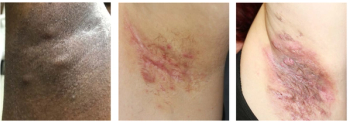
Clinical trials offer hope for hidradenitis suppurativa patients
Clinical trials investigating the efficacy of biologics in treating this condition at Stage 2 and Stage 3 are growing in number and should be considered a front-line treatment option, says this expert.
Patients with the inflammatory condition hidradenitis suppurativa only have one approved treatment option available to them. However, efforts are underway to identify new therapeutic methods that can offer improved outcomes for these individuals, particularly those with more advanced disease.
According to Joslyn Kirby, M.D., a dermatologist with PennState Health Milton S. Hershey Medical Center, the number of clinical trials investigating the efficacy of biologics in treating this condition at Stage 2 and Stage 3 are growing in number and should be considered a front-line treatment option.
“We’re learning a vast amount about what’s happening in the skin with patients who have HS,” she said. “We’re looking at all the different cell types and cytokines that play an even greater role so we can modify these contributors to the pain, drainage, and the incapacity of hidradenitis suppurativa. We’re hoping for even greater patient outcomes.”
Kirby discussed current and emerging hidradenitis suppurativa treatment options during the recent
Currently, she said, adalimumab is the only medication approved by the Food & Drug Administration to treat hidradenitis suppurativa, and it targets TNF. But, the efforts to pinpoint biologics that can also be used to reduce symptoms are increasing. Between 2017 and 2019, the number of clinical trials devoted to this effort grew by 50% with many focusing on interleukin-17 and interleukin-23 inhibitors.
Although identifying the right clinical trial and enrolling patients might be difficult, Kirby said, better outcomes could develop if dermatologists suggest biologic therapy when they first see the scarring and tunneling associated with this condition. Providers and patients can find hidradenitis suppurativa clinical trials
“The challenge occurs if a patient has inferior responsiveness to adalimumab,” she said. “They must go through a three-month wash-out period before participating in a clinical trail.”
The result, she added, could be a delay in symptom relief.
TREATMENT OPTIONS
Currently, Kirby said, dermatologists can offer both medical and surgical treatments for the nodules and abscesses associated with Stage 1 hidradenitis suppurativa. Topical clindamycin, 15-percent topical resorcinol, oral doxycycline, spironolactone, adalimumab and antibiotics can be used medically. With topical resorcinol, patients experience shorter flares, and lesions are 84% clinically resolved. Half of patients experience peeling, however.
Surgical options include 10mg-40mg interlesional steroid injections, punch de-roofing, laser hair removal, marsupialization and excision. Between 25% and 33% of patients experience a lesion recurrence with punch de-roofing, she said.
Options are different for patients with Stage 2 and Stage 3 disease. Stage 2 patients experience nodules, abscesses, sinus tracts, fistula and scarring, and Stage 3 patients can develop multiple fines tracts, fistulas, and scars throughout an entire area.
For these individuals, if a clinical trial isn’t available, Kirby said, dermatologists can try the same medical and surgical therapies available to Stage-1 patients, but they can also add in infliximab and ustekinumab as third-line medical options. She noted that interlesional steroid injections and punch de-roofing can be effective first-line options for Stage 2 disease, but recommended dermatologists pursue localized and regional excisions for Stage 3 patients who need surgical intervention.
TAKEAWAY MESSAGES
Overall, Dr. Kirby said, it’s important for dermatologists to consider a combination of surgical and medical options when treating hidradenitis patients. And, whenever possible, she suggested providers begin pursuing a clinical trial as a potential first-line treatment method for patients who have Stage 2 or Stage 3 disease.
“Any tunnel formation - whether it’s one or multiples - indicates that a clinical trial is a great opportunity for people who haven’t received a biologic therapy before,” she said. “It’s a chance for them to get effective treatment, and an FDA-approved therapy is available later if it doesn’t work.”
References:
Kirby JS. New and future treatments for hidradenitis suppurativa. Presented at: Presented at: 2019 Fall Clinical Dermatology Conference; Oct 18, 2019; Las Vegas.
Newsletter
Like what you’re reading? Subscribe to Dermatology Times for weekly updates on therapies, innovations, and real-world practice tips.

















